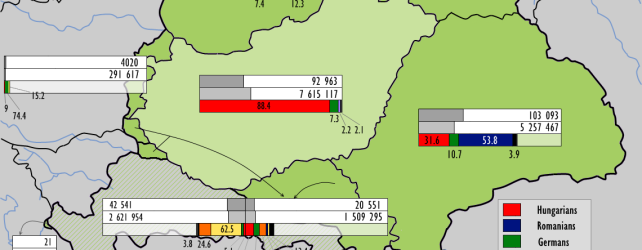Soon after the end of World War I, the Treaty of Trianon—named after the castle in Versailles, France, where it was signed on June 4, 1920—sealed the demise of the Austro-Hungarian empire. In the former two-partite empire, Hungary had controlled parts of modern Slovenia, Croatia, Serbia (Vojvodina), Slovakia, Ukraine, Romania (Transylvania), and Austria (Burgenland). Considered a defeated enemy with minority populations in these regions, the Hungarians were forced to relinquish their control as the treaty established new borders.
As soon as the Treaty of Trianon was signed, the majority of Hungarian politicians declared it unjust. Overt attempts to revise the treaty ensued in the period between the world wars. Such a tendency was unfounded, because the majorities of the populations in these so-called “separated areas” were not Hungarian. It is interesting to note that during Austro-Hungarian rule, Hungary granted privileges to those Jews who opted to declare themselves as Hungarians of the Jewish faith. However, with the upsurge of German Nazism in ‘30s, Hungary joined the Central powers in treating its Jewish citizens as unwanted burdens.
As a result of revisionist tendencies in the Hungarian society, the Turanian Alliance of Hungary was formed in 1920 (also known as the “Turanian Hunters”). This association was founded by the racist Gyula Gömbös, who also served as Miklós Horthy’s defense minister from 1929 to 1932 before dying in 1936 while serving as the Hungarian prime minister. Horthy, an admiral in the former Austro-Hungarian Empire, was picked by this obscure group as a leader who would “return” Hungary to its former glory by reintegrating the lands that were taken from it by the Treaty of Trianon. The Turanian Alliance became an elite gendarmerie unit in service to the Hungarian regent Horthy.
In 1936, the Turanian Alliance numbered 6,000 members, a number which doubled by 1942. In January of that year, horrible war crimes took place in occupied northern Serbia. Hungarian soldiers and gendarmes, aided by Turanian Alliance members, tossed around 25,000 civilians into freezing rivers. Most of the victims were Serbs. Six Jewish communities were obliterated in that outburst of Holocaust and genocide.
Hungarian ethnic minorities in northern Serbia were taken in by Hungarian Nazi propaganda claiming a glorious, restored Hungarian state was coming. Thus, ethnic Hungarians in northern Serbia hailed the occupation troops. The below photo, taken in 1941 in the town of Vrbas, shows Hungarian intellectuals welcoming Horthy’s occupiers:
In the photo, we see Magdalena Seidl, daughter-in-law of Vrbas Turanian Hunter Tibor Kish, an engineer at the Vrbas sugar refinery. Seidl fled northern Serbia prior to its liberation from Hungarian occupation. Her daughter, Magdolna Kish, has filed a rehabilitation request at the court in Novi Sad, Serbia, claiming her grandfather was murdered by Serbian partisans, even though evidence of Tibor Kish’s criminal record and the circumstances of his death has been presented by Dr. Tibor Zagyva, including the photo. Tibor Kish committed individual crimes against a local Serbian family. In April 1944, he actively participated in the deportation of Vrbas Jews to Nazi death camps. He planned to escape from Hungary just prior to the arrival of the liberating Serbian partisans but was prevented by a fellow Turanian Hunter, who murdered him out of jealousy.
Turanian Hunters usually had civilian professions. Membership in the Turanian Alliance was based on free will and usually motivated by racist and chauvinist objectives. The U.S. Department of State’s Foreign Affairs Manual, Volume 9: Visas, lists “Turanian Hunters” as a Nazi formation from World War II because of its war crimes against civilians in countries occupied by Horthy’s Hungary. Organized, state-sponsored genocide was a part of the Turanian program, which consisted of four basic premises:
- “Liberation” of Hungarians who had been “enslaved” following the Treaty of Trianon
- Defending the independence of Greater Hungary
- Establishing internal peace and order
- Strengthening of Hungarian “identity”
The present-day Hungarian Jobbik party has adopted the same approach in resolving the “Hungarian question.” Has history been repeating?








